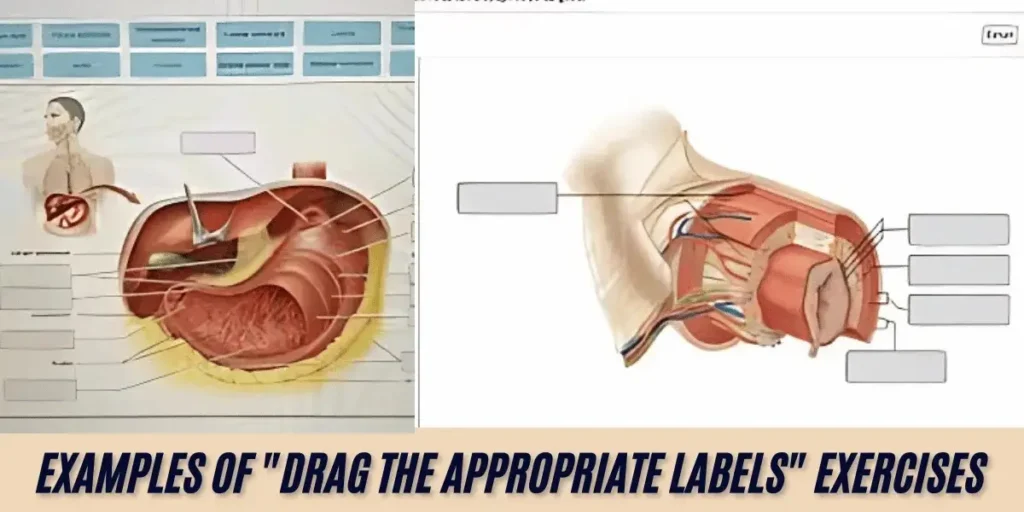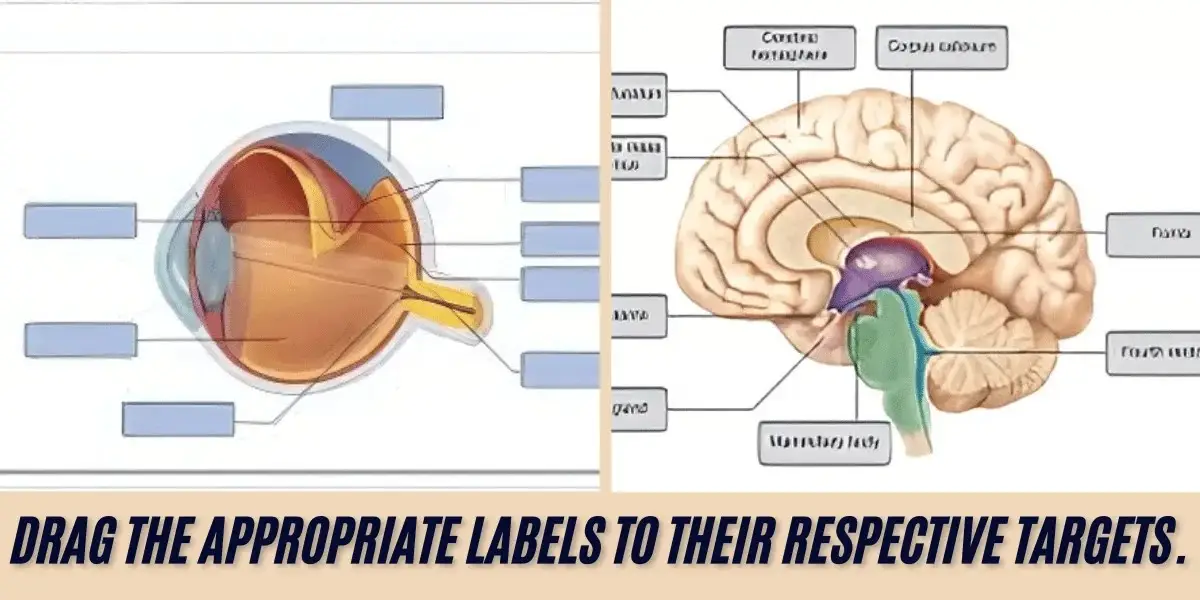In the realm of digital learning, interactive exercises have become a key component of modern educational tools. One such widely used activity is the “drag the appropriate labels to their respective targets.” This interactive exercise is designed to engage learners and help them connect concepts or information through a hands-on, visual approach. It is commonly used in subjects like biology, geography, and even in fields such as language learning and mathematics. In this article, we will explore the importance of this exercise, its applications, and how it can enhance the learning process.
What is the “Drag the Appropriate Labels to Their Respective Targets” Exercise?
“Drag the appropriate labels to their respective targets” is an interactive, drag-and-drop activity used to test a learner’s knowledge or understanding of a subject. In this task, a set of labels (which could be terms, names, or categories) are displayed, and learners are required to drag and place them on the correct corresponding targets or areas in an image, diagram, or chart.
For example, in a biology lesson, a diagram of the human body might appear, and the task could involve dragging labels such as “heart,” “lungs,” or “liver” to the respective parts of the diagram. Similarly, in a geography exercise, a world map may require learners to drag labels for countries or capitals to the correct locations.
How Does the “Drag the Appropriate Labels” Exercise Work?
The exercise typically follows these steps:
- Presentation of Labels and Targets
A set of labels (e.g., names, descriptions, or categories) is presented on one side of the screen. On the other side, there are specific targets or areas (such as images, maps, or charts) that need to be matched with the labels. - Dragging Labels
The learner clicks on a label and drags it across the screen to the correct target area. When a label is placed on the appropriate target, it often locks into place, confirming the match. - Feedback Mechanism
After dragging the labels to the targets, the system may provide immediate feedback, confirming whether the matches are correct or not. If the labels are placed incorrectly, some systems may allow the learner to try again or provide hints. - Completion
Once all labels are correctly matched with their respective targets, the learner may receive a completion message, a score, or be directed to the next activity or level.
Also read: Modern Mullet | It Is Not Wisdom But Authority That Makes A Law. t – Tymoff
Educational Benefits of “Drag the Appropriate Labels to Their Respective Targets”
This type of exercise offers numerous advantages for learners across various age groups and educational levels:
- Enhanced Visual Learning
The exercise supports visual learning by combining text-based information with visual elements like images, diagrams, and charts. By interacting with these elements, learners can more easily comprehend and remember the material. - Active Learning
The “drag and drop” activity promotes active engagement. Instead of passively reading or listening to information, learners are actively involved in applying their knowledge to solve a problem or complete a task. - Memory Reinforcement
Matching labels to the correct targets helps reinforce memory. The act of physically moving the labels encourages learners to think critically about each choice and its connection to the target. This active engagement leads to stronger retention. - Problem-Solving Skills
As learners identify the appropriate labels and targets, they engage in critical thinking and problem-solving. They must assess the available options, recall relevant information, and make decisions that lead to the correct answer. - Immediate Feedback
Many platforms offering this interactive exercise provide immediate feedback. This instant response helps learners recognize errors, make corrections, and understand why a certain label fits a particular target, further enhancing their understanding. - Increased Motivation
The interactive nature of the exercise keeps learners engaged, making the learning process more fun and less monotonous. The challenge of matching labels to targets can encourage learners to continue practicing, fostering a sense of accomplishment when they get it right. - Versatile Application
This exercise can be adapted for a wide range of subjects. Whether it’s matching countries to capitals in geography, parts of speech in language learning, or organs in the human body in biology, the “drag the labels” format can be used to teach a variety of concepts across disciplines.
Examples of “Drag the Appropriate Labels” Exercises

- Science: Anatomy
In biology classes, students can use this exercise to label the parts of a cell, different organs in the human body, or the stages of the water cycle. Each label (such as “nucleus,” “mitochondria,” or “chloroplast”) must be correctly matched with the diagram or model. - Geography: World Map
In geography lessons, students can drag labels for countries, continents, or capitals to the correct spots on a world map. For example, the student might drag a label saying “Paris” to the map of France or “Brazil” to the continent of South America. - Language Learning: Parts of Speech
In language learning, students might be asked to match labels for different parts of speech (like nouns, verbs, adjectives) with examples of sentences or words. This helps learners understand grammar structure and improves language acquisition. - Math: Geometric Shapes
In mathematics, learners could match names of geometric shapes (e.g., “circle,” “square,” “triangle”) to their respective diagrams. This helps reinforce the learner’s understanding of basic geometry. - History: Timeline Events
For history students, a timeline might be presented with several significant events in world history. Learners are then tasked with dragging labels (such as “World War I,” “The American Revolution,” or “The Industrial Revolution”) to the correct spots on the timeline.
How to Create Effective “Drag the Labels” Exercises
Creating an engaging and effective “drag the labels” exercise requires attention to several key elements:
- Clear Instructions
Provide clear instructions at the beginning of the activity to ensure learners understand what they are expected to do. This could include information on how to drag the labels, how to identify the targets, and what to do once all labels are placed. - Appropriate Difficulty Level
The exercise should be challenging but not overwhelming. Labels should be relevant to the learner’s current level of understanding. Too many difficult labels or targets can discourage learners, while too many easy ones may lead to disengagement. - Visually Appealing Design
The design of the exercise should be visually appealing and user-friendly. Labels should be easy to read, and the targets should be clearly defined. Consider using contrasting colors to make labels and targets stand out. - Feedback and Hints
Offering helpful feedback after each attempt can guide the learner toward the correct answers. Providing hints, such as narrowing down the options or showing partial matches, can encourage continued engagement. - Variety of Content
Incorporate a variety of topics and concepts to keep learners interested. The labels can represent different types of content, such as definitions, images, or examples, to provide a more dynamic learning experience.
Key Features of “Drag The Appropriate Labels To Their Respective Targets.”
- Interactive Learning
The exercise promotes active engagement by requiring learners to physically interact with the content, fostering a deeper understanding of the material. - Visual and Hands-On Learning
By combining text-based information with visuals (e.g., images, diagrams, maps), the activity caters to visual learners, enhancing concept retention through hands-on interaction. - Immediate Feedback
Learners receive instant feedback on their answers, allowing them to correct mistakes, reinforcing the learning process and helping them understand the material better. - Adaptability Across Subjects
This exercise can be used in various disciplines such as biology, geography, history, math, and language learning, making it a versatile educational tool. - Customizable Difficulty Levels
The difficulty of the exercise can be adjusted to suit different learning levels, ensuring it is engaging for both beginners and more advanced learners. - Memory Reinforcement
Drag-and-drop tasks help strengthen memory retention by requiring learners to actively match labels to their corresponding targets, reinforcing the information in the process. - Engagement and Motivation
The interactive nature of the exercise keeps learners motivated, turning a typically passive learning experience into an exciting challenge that encourages continued participation. - Supports Multiple Learning Styles
The exercise caters to various learning styles by integrating visual, kinesthetic, and auditory elements, ensuring it is effective for a diverse group of learners. - Progress Tracking
Many platforms offer tracking features, allowing students and educators to monitor progress, identify areas of difficulty, and provide targeted support where necessary. - Easy to Implement
With various digital platforms available, creating and implementing “drag the appropriate labels” exercises is simple for educators, requiring minimal technical expertise while providing impactful learning experiences.
Also read: Constitution Day of India | ww55.affinity.net | Dreamplay1 Login | Free Anime Websites | Your Topics Multiple Stories
Conclusion: Drag The Appropriate Labels To Their Respective Targets.
The “Drag The Appropriate Labels To Their Respective Targets.” exercise is an invaluable educational tool that promotes active learning and reinforces understanding across various subjects. By combining visual elements with hands-on interaction, this exercise boosts engagement, improves memory retention, and helps develop critical thinking and problem-solving skills. Whether in science, geography, or language learning, this interactive activity offers learners a dynamic way to connect theoretical knowledge with practical application. Whether you are an educator or a student, incorporating this exercise into your learning routine can significantly enhance the educational experience, making it both effective and enjoyable.
FAQ: Drag The Appropriate Labels To Their Respective Targets.
1. How does this exercise benefit students?
It benefits students by promoting active learning, reinforcing memory, improving critical thinking, and offering immediate feedback. It also increases motivation and engagement, making learning more fun and effective.
2. Is this exercise suitable for all age groups?
Yes, the “drag the labels” exercise can be adapted for various age groups. For younger learners, simple and colorful designs with basic concepts are used, while for older students, more complex topics and designs are incorporated.
3. Is this exercise effective for remote learning?
Absolutely! The “drag the labels” exercise is highly effective for remote and online learning. It engages students in a digital environment, allowing them to practice and interact with concepts from the comfort of their home.
4. Can this exercise be used for assessments?
Yes, this exercise can be used as a formative or summative assessment. Teachers can use it to test students’ understanding of concepts and monitor their progress based on their performance in labeling tasks.
5. How can I make the exercise more challenging?
To make the exercise more challenging, you can increase the number of labels, use more complex diagrams, add multiple possible targets for each label, or create time-based challenges. You can also incorporate different types of content, such as definitions or explanations, instead of just images.



